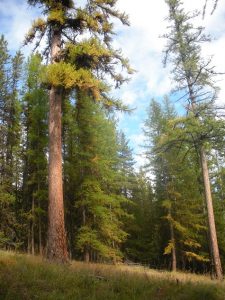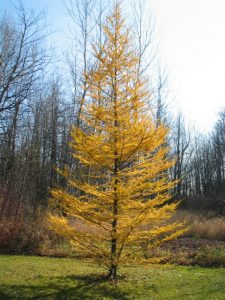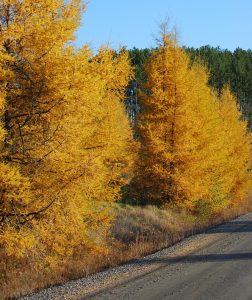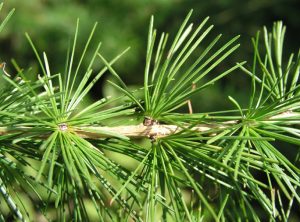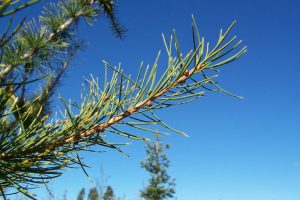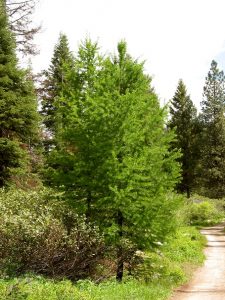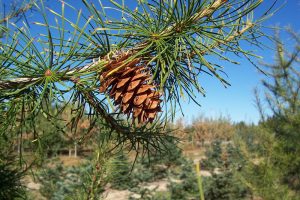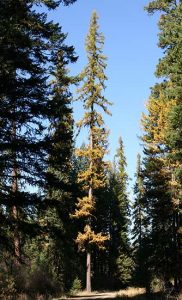Western Larch
Western larch, also known as western tamarack or tamarack, is a species of large deciduous conifers found on the lower mountain slopes and valleys of western North America, as well as in parts of Canada and the United States. Although it is typically found in forests with mixed species of trees, it can sometimes grow in pure groups. It has a pyramidal form with level to upswept main branches and sagging side branches.
Scientific Classification
| Kingdom | Plantae |
| Division | Pinophyta |
| Class | Pinopsida |
| Order | Pinales |
| Family | Pinaceae |
| Genus | Larix |
| Scientific Name | Larix occidentalis |
Quick Information
| Other Names | Montana larch, mountain larch, hackmatack, mélèze occidental (French) |
| Size | 30-60 m (98-197 ft) tall; trunk diameter of 1.5 m (4.9 ft) |
| Leaves (Needles) | Very slender, 2-5 cm long; light green in spring turning yellow in the fall; cross-section is triangular; clustered in groups of 15-30 on old twigs |
| Cones | Red when young turning reddish-brown when mature, 2-5 cm long, egg-shaped with 40-80 woody scales, each of which bears a protruding bract |
| Bark | Gray-brown, thin, and scaly in young trees; it becomes 3-6 inches thick, developing deep furrows, turning yellow or reddish brown |
| Crown/Top | Narrow conic |
| Distribution/Range | Alberta and British Columbia in Canada; Oregon, Idaho, Washington, and NW Montana in the United States |
| Hardiness Zones | 2-6 |
| Growth Rate | Medium in the initial stages but high (greater than 50 cm a year) after the establishment period |
| Lifespan | Probably more than 800 years |
| Growing Conditions | Winter Conditions: Moist and very cold; average annual minimum temperature is -9° C Summer Conditions: Cool summers; grows well during May-August when the average temperature is 16° C Rain: Moderate rainfall; its native range receives 450-875 mm of precipitation per year Sunlight: Shade-intolerant; requires exposure to full sun Soil Requirements: Deep, porous, well-drained, medium or coarse-textured soil; somewhat tolerant to acidic substrates |
| Diseases and Pests | Dwarf mistletoe, red ring rot, needlecast, and the fungus Fomitopsis officinalis are some of the serious diseases; insect pests such as western spruce budworm, larch casebearer, larch bud moth, and larch sawfly cause damage |
| Flowering/Fruiting | Seed cones and pollens appear between mid-April and mid-May; pollination takes place from late May-early June; cones mature by late-August |
| Breeding System | Monoecious |
| Seed Production | Production of cones and seeds is less common on trees under 25 years |
| Seedling Development | Seeds germinate from late April-early June, adapted to seedbeds uncovered by mechanical scarification or burning |
| Wildlife Value | Some birds including two-barred crossbills, redpolls, and pine siskins feed on the seeds; western larch trees provide shelter to deer, moose, elk, bears, and hole-nesting birds |
| Cultivars | A few varieties exist including the broom-shaped Larix occidentalis cv. ‘Bollinger’ |
| Uses | The wood is used for fine veneer, railroad ties, lumber, mine timbers, long utility poles, pulpwood in papermaking; a water-soluble gum, called Arabinogalactan, from the bark is used in paint, ink, pharmaceutical, food, and offset lithographic printing industries |
| IUCN Conservation Status | Least Concern |
Interesting Facts
- The Seeley Lake Giant, found in Lolo National Forest in Montana, is the largest known western larch with a height 49.4 m, dbh 221 cm, and stem-volume 83 m3.
- By counting the annual rings from a sawn-off stump near Cranbrook, British Columbia, the age of the supposedly oldest western larch was estimated at 920 years.
- Some indigenous people of the Plateau consumed a drink prepared from the shoots for the treatment of laryngitis and tuberculosis.
- The western larch wood is valuable as firewood, and while burning, it gives off a sweet fragrance.
References
- https://en.wikipedia.org/wiki/Larix_occidentalis
- https://www.fs.usda.gov/rm/pubs_journals/2020/rmrs_2020_steed_j001.pdf
- http://dendro.cnre.vt.edu/dendrology/syllabus/factsheet.cfm?ID=214
- https://www.fs.usda.gov/rm/pubs_journals/2020/rmrs_2020_steed_j001.pdf
- https://www.iucnredlist.org/species/42315/2971858
- https://www.for.gov.bc.ca/hfd/library/documents/treebook/westernlarch.htm


